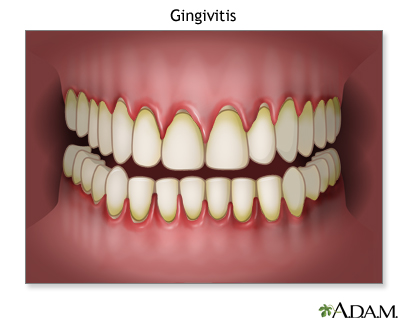Pregnancy SmartSiteTM
Teeth - caring for; Oral hygiene; Dental hygiene DefinitionTooth decay and gum disease are caused by plaque, a sticky combination of bacteria and food. Plaque begins to build up on teeth within a few minutes after eating. If teeth are not cleaned well each day, plaque will lead to tooth decay or gum disease. If you do not remove plaque, it turns into a hard deposit called tartar that becomes trapped at the base of the tooth. Plaque and tartar irritate and inflame the gums. Bacteria and the body's inflammatory response to it cause the gums to become:
By taking good care of your teeth and gums, you can help prevent problems such as tooth decay (caries) and gum disease (gingivitis or periodontitis). You should also teach your children how to brush and floss from an early age to help them protect their teeth. Plaque and tartar lead to a number of problems:
 InformationHOW TO TAKE CARE OF YOUR TEETH Healthy teeth are clean and have no cavities. Healthy gums are pink and firm, and do not bleed. To maintain healthy teeth and gums, follow these steps:
Regular teeth cleaning by a dentist or dental hygienist removes plaque that may develop, even with careful brushing and flossing. This is very important for getting at areas that are hard to reach on your own. Professional cleaning includes scaling and polishing. This procedure uses instruments to loosen and remove deposits from the teeth. Routine exams may include dental x-rays. Your dentist can catch problems early, so they do not become more serious and expensive to fix. Ask your dentist or dental hygienist:
WHEN TO CONTACT THE DENTIST Contact your dentist if you have symptoms of a cavity that include:
Get early treatment for gum disease. Contact your dentist if you have symptoms of gum disease that include:
 ReferencesChow AW. Infections of the oral cavity, neck, and head. In: Bennett JE, Dolin R, Blaser MJ, eds. Mandell, Douglas, and Bennett's Principles and Practice of Infectious Diseases. 9th ed. Philadelphia, PA: Elsevier; 2020:chap 64. Stefanac SJ. Developing the treatment plan. In: Stefanac SJ, Nesbit SP, eds. Diagnosis and Treatment Planning in Dentistry. 4th ed. St Louis, MO: Elsevier; 2024:chap 5. Teughels W, Feres MF, Ganesan SM, Gidley MD, Hernandez-Kapila YL, Jakubovics N. Biofilm and periodontal microbiology. In: Newman MG, Klokkevold PR, Elangovan S, Hernandez-Kapila YL, eds. Newman and Carranza's Clinical Periodontology and Implantology. 14th ed. St Louis, MO: Elsevier; 2023:chap 10. | |
| |
Review Date: 3/31/2024 Reviewed By: Michael Kapner, DDS, General Dentistry, Norwalk Medical Center, Norwalk CT. Review provided by VeriMed Healthcare Network. Also reviewed by David C. Dugdale, MD, Medical Director, Brenda Conaway, Editorial Director, and the A.D.A.M. Editorial team. The information provided herein should not be used during any medical emergency or for the diagnosis or treatment of any medical condition. A licensed medical professional should be consulted for diagnosis and treatment of any and all medical conditions. Links to other sites are provided for information only -- they do not constitute endorsements of those other sites. No warranty of any kind, either expressed or implied, is made as to the accuracy, reliability, timeliness, or correctness of any translations made by a third-party service of the information provided herein into any other language. © 1997- A.D.A.M., a business unit of Ebix, Inc. Any duplication or distribution of the information contained herein is strictly prohibited. | |

 Teach children to ...
Teach children to ... Periodontitis
Periodontitis Denture care
Denture care Gingivitis
Gingivitis
